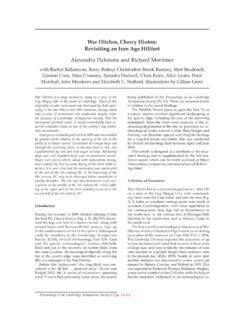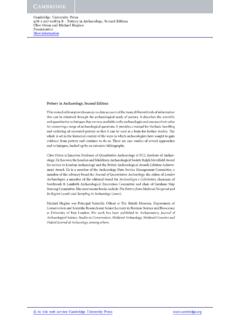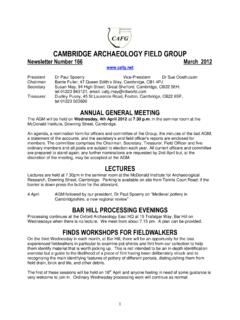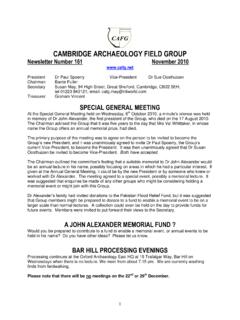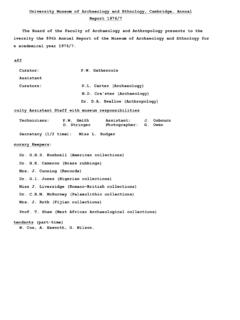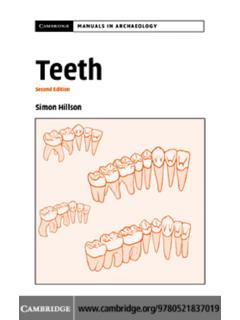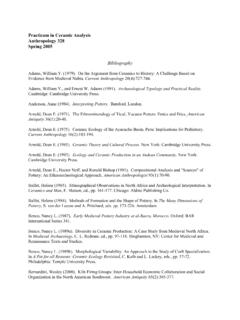Transcription of ARCH 0295: Artifacts in Archaeology: Understanding ...
1 ARCH 0295: Artifacts in archaeology : Understanding material Culture and Ancient Technologies 2 Instructor: Clive Vella Joukowsky Institute for archaeology and the Ancient World Tuesdays 4 -6:20pm, Rhode Island Hall #008 Office Hours: M 2 - 4pm Course wiki: Prerequisites: none Course description The manufacture of Artifacts distinguishes us from all other species. Inevitably, the study of these Artifacts and other material culture form a significant part of archaeological interpretation. In fact, through the study of material culture we can ask exciting questions such as: how does technology emerge during human evolution? What kind of material culture do archaeologists deal with? How can we interpret such material culture? Artifacts , material culture and technology form an unbreakable bond with our human existence.
2 However, archaeologists often struggle with interpreting material culture, especially since Artifacts such as stone tools are unlike any present day technology. In the meantime, archaeologists have often made the mistake of using present-day comparisons to understand the use of past Artifacts . But this is in fact a highly erroneous and problematic way to study ancient material culture. Therefore, in this course we will go through the basic artifact types that archaeologists most commonly recover: lithics, pottery and metallurgy. We will precede these Artifacts by asking ourselves: What is technology? How should we debate it? Then we will look at the technological basics, classification methods and interpretational methods utilized to understand lithics, pottery and metallurgy.
3 To further comprehend these technologies, class will alternate between discussing the distinct material culture types and detailed overviews of important case-studies. We will also overview other, lesser-found artifact types including glass, wood and bone. Further, the course will discuss scientific means for the characterization of Artifacts . Such studies have played large roles in recent archaeological studies since it permits archaeologists to fingerprint raw materials and trace their distribution over 3 space. Our final aim for the course will be to discuss interpretation paradigms used by archaeologists. Therefore, we will discuss interpretational modes such as processualism, post-processualism and current models, such as agency theory, operational sequences etc.
4 In this class students will be encouraged to consider the importance of archaeological material culture in aiding us to comprehend our human past. The course will also illustrate that a solid comprehension of various technological processes and properties can aide us to grasp a better sense of human choices and adaptation. Aims and Objectives Envisioned as a higher undergraduate course, this class will seek to introduce students to theoretical concepts and a solid background into archaeological material culture. Therefore, this class will concentrate on the following key questions and issues: How does technology emerge during human evolution? What kind of material culture do archaeologists deal with? How can we interpret such material culture? The course is divided in the following format: Week 1: Introduction to material Culture Week 2: Technology, Teknos and material Culture Week 3: Lithic and stone technology Week 4: Lithics in human evolution Week 5: Ceramic technology Week 6: Early ceramics vs Roman mass-production Week 7: Metallurgy technology Week 8: The Metal Ages Week 9: The unusual suspects : Glass, Wood, Bone Week 10: Scientific characterization 4 Week 11: Interpretation methods Week 12: Presentations (1) Week 13: Presentations (2) Assessment The assessment is broken down in the following manner: Attendance 20% Case-study 30% (Presentation: 15%.)
5 Paper: 15%) 3 Quizzes 50% Since the larger scope of this class is meant to supply students with crucial information for their archaeological education, the assessment for this class is meant to ensure the gradual comprehension of the subject-matter. Students are encouraged to select a material culture, artifact type and case-study of their interest and present their interpretations in Week 12 in a 10 minute interpretation. This presentation will be accompanied by a 10 page double-spaced paper discussing these results. Finally, 3 multi-choice quizzes will be set (Weeks 4, 8 and 11) on materials discussed in the previous weeks. Week 1: Introduction to Artifacts and material Culture In this week s class we will discuss the usefulness of material culture to archaeology .
6 What kind of questions can we answer through material culture? What is the plethora of material culture that archaeologists are often faced with? How do archaeologists study these artifacs? Rouse, I. 1960. The Classification of Artifacts in archaeology . American Antiquity: 313 323. Banning, Edward Bruce. 2000. The Archaeologist s Laboratory: The Analysis of Archaeological Data. Springer. 5 Week 2: Technology, Teknos and material Culture Underpinning the production of Artifacts is the connection between humans and their respective technologies. In this class we will try to define technology and find a useful way through which we can look at material culture over time. Deetz, J. 1996. In Small Things Forgotten: The archaeology of Early American Life. Anchor Books, pgs 165-186. Dobres, Marcia-Anne.
7 2010. Archaeologies of Technology. cambridge Journal of Economics 34 (1): 103 114. Lemonnier, P. 1986. The Study of material Culture Today: Toward an Anthropology of Technical Systems. Journal of Anthropological archaeology 5 (2): 147 186. Nye, D. E. 2006. Technology Matters: Questions to Live With. MIT Press, pgs 1-15. Week 3: Lithic and stone technology Lithic technology is all about angles and force. However, archaeologists can tell quite a lot from their lithic assemblages. In this class we will discuss the technological attributes that archaeologists can identify and their effect on archaeological interpretations. Andrefsky, W., 1998. Lithics : macroscopic approaches to analysis, cambridge Manuals in archaeology . cambridge University Press, cambridge , pgs 11-40. Kooyman, , 2001. Understanding Stone Tools and Archaeological Sites.
8 University of New Mexico Press, New Mexico, pgs 11-24. Week 4: Lithics in human evolution The first hominids are distinguished due to their proficient tool-making during the Late Paleolithic. In this class we will broadly look at the main lithic technologies over time and across numerous hominids including Homo Erectus, Homo Neanderthalensis and 6 Homo Sapiens Sapiens. We will also ask ourselves: how does tool-making distinguish us from our primate cousins? What are the cognitive necessities to produce lithic tools? Ambrose, S. 2001. Paleolithic Technology and Human Evolution. Science 291 (5509): 1748 1753. Kenmotsu, N. 1990. Gunflints: A Study. Historical archaeology : 92 124. Whittaker, J. C. 2004. American Flintknappers: Stone Age Art in the Age of Computers. Univ of Texas Pr, pgs 112-146 Week 5: Ceramic technology In this class we will discuss ceramic as an additive type technology, unlike lithics in the previous week.
9 We will go over the principles and process for ceramic production. We will also look at ceramics and the way in which archaeologists seeks to extrapolate information from this type of material culture. Rice, P. M. 1987. pottery Analysis. Univ. of Chicago Pr, pgs 207-243. Sinopoli, C. M. 1991. Approaches to Archaeological Ceramics. Springer, pgs 9-33. Week 6: Early ceramics vs Roman mass-production Ceramics seem to have originated in the Near East after 7,000 BC alongside farming and permanent sedentism. Indeed, ceramics appears to have provided their communities with their ability to store, carry and cook, a facet previously missing in human culture. On the other hand, later ceramic technology produced during the Roman Empire appears to have been mass-produced and meant to cater for a specific market demand.
10 In this class we will cross-compare ceramic technology at two very different time-periods and discuss the usefulness of ceramics for archaeological interpretation. Mirti, P., Appolonia, L., Casoli, A., 1999. Technological Features of Roman Terra Sigillata from Gallic and Italian Centres of Production. Journal of Archaeological Science 26, 1427 1435. 7 Moore, , 2003. The Abu Hureyra Project: Investigating the beginning of Farming in Western Asia., in: Ammerman, , Biagi, P. (Eds.), The Widening Harvest: The Neolithic Transition in Europe: Looking Back, Looking Forward. Archaeological Institute of America, Boston, pp. pgs 59 74. Rice, 1999. "On the origins of pottery ". Journal of Archaeological Method and Theory, 6 (1): 1-54. Week 7: Metal technology The production of metal material culture is a complex process that would have required know-how and significant pre-planning by past communities.
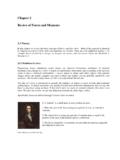
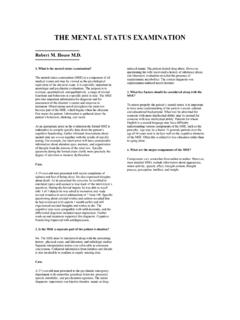



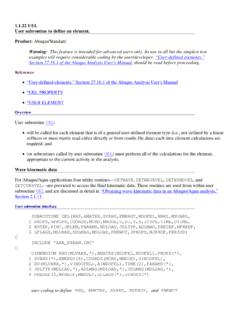
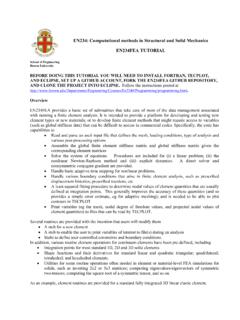


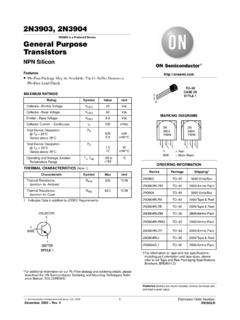
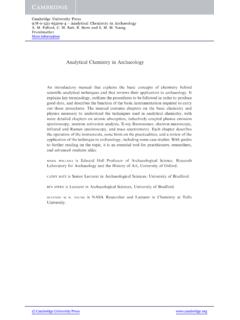
![Handout 1 — Prehistoric Ceramics [11/2015]](/cache/preview/a/e/d/f/3/9/8/7/thumb-aedf398775325961568d0a6b677d6574.jpg)
